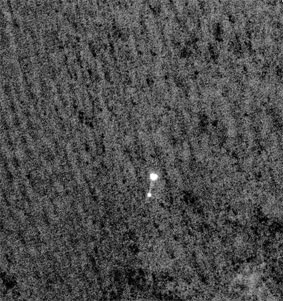 |
| A telescopic camera in orbit around Mars caught a view of NASA's Phoenix Mars Lander suspended from its parachute during the lander's successful arrival at Mars Sunday evening, May 25.聽 (NASA/JPL/University of Arizona) |
"I am very happy to see a soft landing for the Phoenix Mars Scout on the Northern Martian Plains," says Tom Duck, a co-investigator of the Canadian Science Team and professor with AV俱乐部's Department of Physics and Atmospheric Science. "Landing represents the culmination of a lot of effort from the Phoenix team including the Canadian contributors鈥擸ork University, AV俱乐部, University of Alberta, MDA, Optech and CSA."聽
SEE PHOTOS: Maple Leaf on Mars
With his team of graduate students at AV俱乐部, Prof. Duck designs and builds lidar systems to study ice clouds in Canada's high Arctic. His expertise helped fine-tune the lidar on Phoenix and he is responsible for the scientific guides and procedures used for operating MET station on Mars and receiving data back on Earth.
"Now that the lander is safely on Mars the real excitement begins: The Canadian instrumentation will explore the Martian atmosphere using a lidar (laser radar) system ...聽Our team will be stationed at the Science Operations Center at the University of Arizona and will be sending commands to the lander and analyzing the data as it is transmitted back to us. The measurements will give us a first view of the atmospheric structure on Mars from the vantage point of the surface."
 |
| Tom Duck on the roof of the Dunn building with a lidar. (Danny Abriel Photo) |
With聽about three months to explore, researchers will use the Phoenix to look for water.聽
"An important goal of the mission is to try to understand the water cycle, and so we will be very interested to see if there are clouds and fogs amongst the dust," adds Dr. Duck.
"We will also be keenly watching what is happening with other instruments on the lander, and in particular whether or not Phoenix 'tastes the water' in ice thought to exist not far below the surface."
